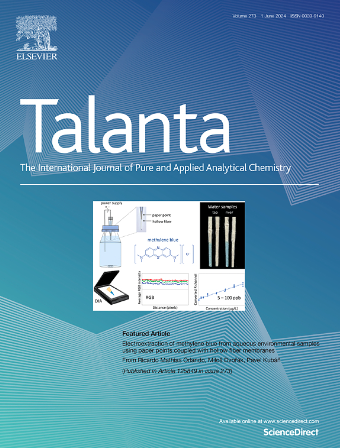Developing a polarity-specialized TICT fluorescent probe for wash-free and long-term monitoring lipid droplets dynamics
IF 5.6
1区 化学
Q1 CHEMISTRY, ANALYTICAL
引用次数: 0
Abstract
Lipid droplets (LDs) are dynamic and multifunctional organelles that play a crucial role in energy storage, metabolism and lipid signaling. Monitoring the dynamics of LDs is essential for understanding their functions. Twisted intramolecular charge transfer (TICT)-based fluorescent molecules have been widely utilized for LD imaging. However, conventional TICT dyes exhibit sensitivity to both polarity and viscosity, which results in unclear sensing mechanisms for LDs. Additionally, current LD imaging techniques face challenges such as complex washing procedures and limited long-term imaging capabilities. This study presented a far-red coumarin framework designed to modulate the TICT-ICT equilibrium, resulting in the development of two fluorophores that exhibit specialized sensitivity to either polarity or viscosity. The findings suggested that sensitivity to polarity is a crucial factor for LD imaging, as high signal-to-noise ratios (SNR) enable wash-free imaging, while suitable lipophilicity supports long-term imaging. This polarity-specialized TICT probe had the potential to revolutionize LD imaging, facilitating wash-free and extended studies of LD dynamic behaviors and functions during lipolysis.

开发极性专用的免洗和长期监测脂滴动态的TICT荧光探针
脂滴是一种动态的、多功能的细胞器,在能量储存、代谢和脂质信号传导中起着至关重要的作用。监测ld的动态对于了解其功能至关重要。基于扭曲分子内电荷转移(TICT)的荧光分子已广泛用于LD成像。然而,传统的TICT染料对极性和粘度都很敏感,这导致了对ld的传感机制不清楚。此外,当前的LD成像技术面临着复杂的清洗程序和有限的长期成像能力等挑战。本研究提出了一种远红色香豆素框架,旨在调节TICT-ICT平衡,从而开发出两种对极性或粘度具有特殊敏感性的荧光团。研究结果表明,对极性的敏感性是LD成像的关键因素,因为高信噪比(SNR)可以实现无水洗成像,而合适的亲脂性支持长期成像。这种极性专用的TICT探针有可能彻底改变LD成像,促进脂肪分解过程中LD动态行为和功能的无清洗和扩展研究。
本文章由计算机程序翻译,如有差异,请以英文原文为准。
求助全文
约1分钟内获得全文
求助全文
来源期刊

Talanta
化学-分析化学
CiteScore
12.30
自引率
4.90%
发文量
861
审稿时长
29 days
期刊介绍:
Talanta provides a forum for the publication of original research papers, short communications, and critical reviews in all branches of pure and applied analytical chemistry. Papers are evaluated based on established guidelines, including the fundamental nature of the study, scientific novelty, substantial improvement or advantage over existing technology or methods, and demonstrated analytical applicability. Original research papers on fundamental studies, and on novel sensor and instrumentation developments, are encouraged. Novel or improved applications in areas such as clinical and biological chemistry, environmental analysis, geochemistry, materials science and engineering, and analytical platforms for omics development are welcome.
Analytical performance of methods should be determined, including interference and matrix effects, and methods should be validated by comparison with a standard method, or analysis of a certified reference material. Simple spiking recoveries may not be sufficient. The developed method should especially comprise information on selectivity, sensitivity, detection limits, accuracy, and reliability. However, applying official validation or robustness studies to a routine method or technique does not necessarily constitute novelty. Proper statistical treatment of the data should be provided. Relevant literature should be cited, including related publications by the authors, and authors should discuss how their proposed methodology compares with previously reported methods.
 求助内容:
求助内容: 应助结果提醒方式:
应助结果提醒方式:


